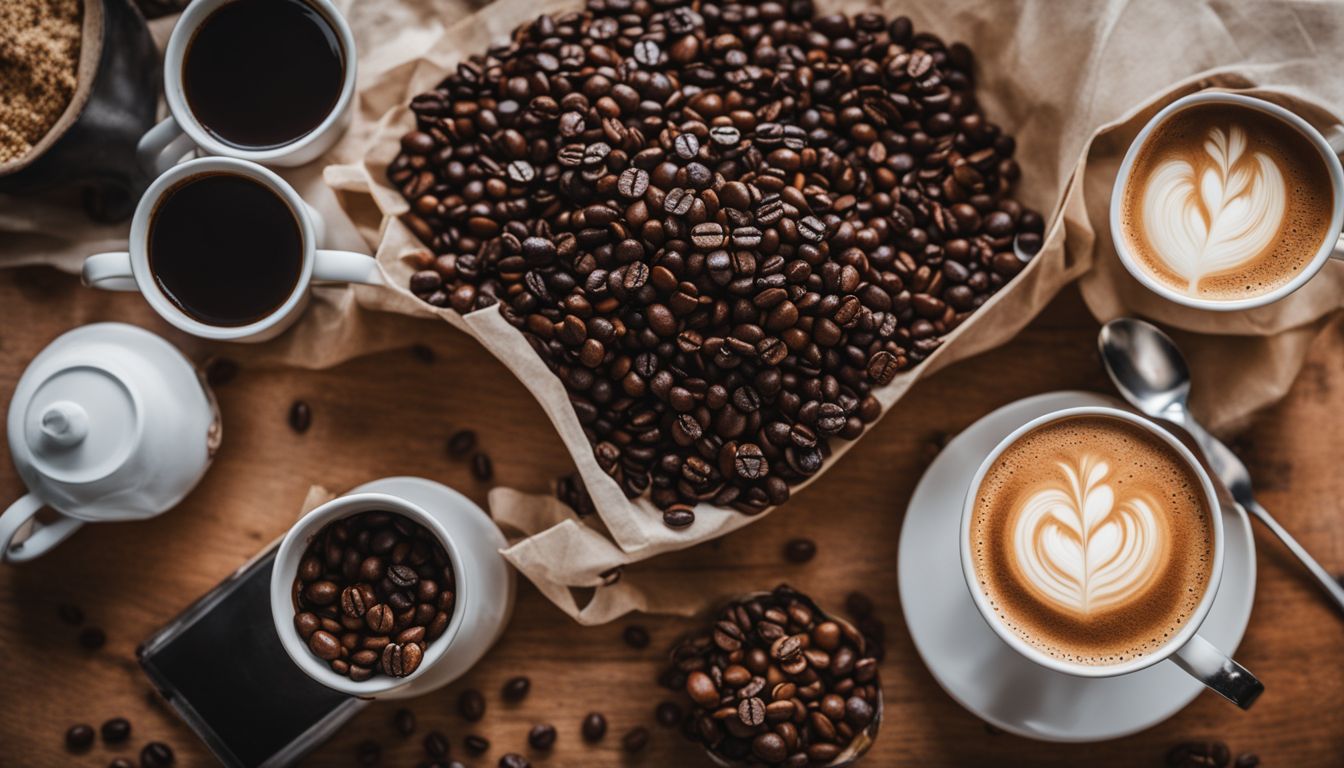Are you overwhelmed by all the different specialty coffee varieties? Trust me, I’ve been there. In my quest to understand this rich world of beans and brews, I’ve compiled a number of insights and practical tips in CoffeeGrindGuru’s coffee tasting guide.
This blog will break down everything from bean selection to brewing methods, revealing how you can transform your routine cup into a sensory experience. Let’s get steeped in knowledge!
Key Takeaways
- This beginner handbook helps you explore the world of coffee flavors and improve your tasting skills.
- It provides step-by-step instructions on coffee tasting techniques, including smelling the aroma, testing for acidity, sweetness, and bitterness, and feeling the body or texture.
- The guide also offers tips for setting up a coffee tasting at home and provides a checklist of essential supplies needed.
- Important factors to consider when tasting coffee include acidity, sweetness, bitterness, body, and flavor notes. Paying attention to these factors will help you appreciate the different aspects of each cup.
[ez-toc]
What Is Coffee Tasting?

Coffee tasting is the process of evaluating and analyzing the different flavors, aromas, and characteristics of coffee beans to fully appreciate the complexity and quality of a cup of coffee.
Benefits of Coffee Tasting
Coffee tasting is a fun way to spot different flavors in coffee. You learn how to talk about your taste with others. It helps you find what tastes best for you. It trains your tongue to know the traits of good coffee beans.
With this skill, drinking coffee becomes more than just a morning routine.
Ways of Coffee Tasting
I love tasting coffee in different ways. These methods let me enjoy a range of flavors, aromas, and profiles.
- I smell the aroma first. I do this before sipping to understand the coffee’s scent better.
- I taste the acidity next. This tells me how “bright” or tart the coffee is.
- Then, I test for sweetness and bitterness by letting it rest on my tongue.
- Feeling its body or texture is important too. I roll it around in my mouth to feel if it’s light or heavy.
- The flavor notes come last but not least! They can hint at the roast, country of origin, or the washing method used on the beans.
Tips for Getting Started
Let’s talk about how you can start coffee tasting. I’ve put together a simple list of tips to help you out:
- Start with coarsely ground coffee: This type of coffee is easy to work with and will give you a clear flavor profile.
- Use your tastebuds: It may seem obvious, but the most essential tool for tasting coffee is your own sense of taste. Your tastebuds will help you explore and understand the different flavors of coffee.
- Take it slow: Don’t rush through the process. Enjoy each sip and try to notice all the little details that make each cup of coffee unique.
- Keep track of what you taste: Write down your thoughts as you taste each cup. You can note down flavors, smells, and even feelings that a particular blend gives you.
- Share the experience: Invite friends over for a coffee tasting party or join an online group where people share their tasting experiences.
Setting Up Coffee Tasting
To set up a coffee cupping at home, you’ll need a few key supplies and follow the below 7 steps.
What You Need
To set up your own coffee tasting at home, you’ll need a few key items. Here’s what you’ll need:
- Roasted beans: Choose high-quality coffee beans to get the best flavors.
- Hot water: Use freshly boiled water that has cooled slightly to extract the flavors from the beans.
- Brewing methods: You can use a French press, pour-over, or any other method that suits your preferences.
- Grind texture: A medium-coarse grind texture, similar to table salt, is recommended for tasting coffee at home.
- Taste buds: Having functional taste buds is essential for experiencing and identifying different flavor profiles.
- Sensory experience: Coffee tasting is all about engaging your senses of taste and smell to discover new flavors.
- Coffee tasting guide: Use a guide or checklist to help you record your findings and communicate about coffee tasting.
7 Steps to Cup Coffee at Home
Cupping coffee at home is a fun and rewarding experience. Here are the seven steps to help you get started:
- Gather your supplies: You’ll need fresh coffee beans, a grinder, scale, timer, hot water, cupping bowls, spoons, and a notepad for recording your findings.
- Grind the coffee: Start by grinding 2 grams of the first coffee to prime the grinder. Then, grind the remaining 18 grams of coffee to a medium-coarse consistency.
- Prepare the water: Heat water to just below boiling point (around 200°F or 93°C). Use filtered water for better taste.
- Smell the dry grounds: Take a moment to inhale the aroma of the dry coffee grounds. Pay attention to any distinct scents or notes.
- Add hot water: Pour hot water over the grounds until they are fully submerged. Let it steep for around 4 minutes.
- Break the crust: Gently break the top layer of floating grounds with a spoon while taking note of any aromas released.
- Taste and evaluate: Using a spoon, take small sips of the coffee and let it coat your palate. Pay attention to acidity, sweetness, bitterness, body, and any tasting notes that stand out.
5 Things to Look for When Tasting Coffee

When tasting coffee, there are five important factors to consider: acidity, sweetness, bitterness, body, and flavor notes.
Acidity
Acidity in coffee is an important thing to consider when you’re tasting it. It’s often called “brightness” and can actually be a good thing. The acidity gives the coffee a tart or citrusy taste, making it vibrant and zesty.
You might also hear words like sharp, tangy, crisp, lively, refreshing, or fruity to describe the acidity of coffee. But be careful – too much acidity can make the coffee taste sour.
So finding the right balance is key. Just remember that over roasted or over extracted coffee can result in a taste that has both ashiness and acidity. So when you’re tasting your coffee, pay attention to how acidic it is and decide if you enjoy that brightness or prefer something milder instead.
Sweetness
The first thing I look for when tasting coffee is the sweetness. It’s all about that sugary taste that makes the coffee enjoyable. I pay attention to the level of sweetness and think about what type of sugar it reminds me of.
Did you know that sweetness in coffee comes from sugars, glycols, alcohols, and amino acids present in the beans? Lighter roasts may even have a fruiter sweetness compared to darker roasts.
So, next time you taste your coffee, take a moment to savor its sweetness and appreciate the different flavors it brings.
Bitterness
Bitterness in coffee is something we often want to avoid, especially if we’ve had bad experiences with it before. Back in the day, when specialty roasters and home coffee grinders weren’t as common, bitterness was more likely to be present.
But nowadays, good quality coffee should have minimal bitterness. That being said, darker roasts can enhance the bitterness if that’s what you’re into. It really comes down to personal preference – some people love a bit of bitterness in their cup while others don’t enjoy it as much.
The level of bitterness can also be influenced by factors like the type of coffee bean used, the roast level, and even your brewing method. So next time you taste your coffee, pay attention to its bitterness and decide whether it’s something you enjoy or not!
Body
The body of coffee refers to how it feels in your mouth. It’s like the weight and thickness of the coffee on your tongue. The body can range from light to medium to full, depending on factors like how it’s brewed and roasted.
When you taste coffee, pay attention to the body because it affects how you perceive other flavors like acidity and sweetness. Is the body thin or heavy? Does it feel rich and creamy or more watery? These are all things to consider when evaluating a coffee’s body.
Flavor Notes

When tasting coffee, one crucial thing to pay attention to is the flavor notes. These are descriptors that help us identify and appreciate the different flavors present in a cup of coffee.
Some common flavor notes include citrus, floral, berry, chocolatey, nutty, buttery, caramel, smoky, spicy, sweet, sour, and vanilla. By understanding these flavor notes and being able to recognize them in our coffee, we can better choose the type of coffee that suits our taste preferences.
It’s like uncovering the hidden complexities and nuances in every sip! So next time you’re enjoying a cup of joe, take a moment to think about the flavors you can detect and see if any specific flavor notes stand out to you.
4 Tips for Getting Started with Coffee Tasting
Start simple by trying different types of coffee from various origins and roasts to develop your palate. Record your findings in a tasting journal to track your preferences and discoveries.
Be patient with yourself as it takes time to refine your tasting skills. Lastly, make coffee tasting a social activity by inviting friends or joining local coffee clubs to share the experience and learn from others.
Start Simple
When it comes to coffee tasting, starting simple is the key. As a beginner, it’s important to focus on understanding the basic principles of coffee tasting. This means paying attention to the aroma profile, acidity level, body texture, and flavor notes of different coffees.
By comparing and contrasting different types of coffee, you can start developing your palate and identifying the unique characteristics of each brew. It’s also helpful to record your findings and make it a social activity by sharing your thoughts with others who enjoy a coffee tasting.
Remember that developing a vocabulary for describing taste and characteristics will enhance your overall experience in the world of coffee tasting.
Record Your Findings
In my beginner’s guide to coffee tasting, one important tip is to record your findings. As you embark on your coffee sensory journey, it’s essential to keep track of the flavors and characteristics you discover.
By documenting your coffee tasting experiences, you can develop a better understanding of your preferences and refine your palate over time. Whether it’s through a dedicated coffee tasting journal or an app on your phone, find a method that works for you and make it a habit.
This way, you can look back on your notes and see how far you’ve come in exploring the diverse world of coffee flavors.
Be Patient
When starting with coffee tasting, it’s important to be patient. It may take time to develop your taste buds and understand the complexities of different flavors. Don’t rush the process – take your time to savor each sip and truly appreciate the nuances in every cup.
Patience is key in honing your palate and discovering what you enjoy most about coffee tasting. So, embrace the journey and allow yourself to learn and grow as a coffee taster. With patience, you’ll gradually become more confident in discerning various flavor profiles and enjoying this sensory experience to its fullest potential.
Make it Social
Coffee tasting doesn’t have to be a solitary activity. It can be a fun and social experience that you can share with friends and coffee enthusiasts. Gather your friends, set up a coffee tasting session, and start exploring different flavors together.
Not only will you get to try new coffees, but you’ll also have the opportunity to engage in conversations about brewing methods, coffee culture, and flavor profiles. By making it social, you not only enhance your own experience but also create opportunities for friendships to grow over shared experiences and conversations around the wonderful world of coffee tasting.
So grab some cups, invite your friends over, and let the exciting journey of discovering new flavors begin!
Frequently Asked Questions
How Do I Start Tasting Coffee Like a Beginner?
What Should I Look for When Tasting Coffee?
Do I Need Any Special Equipment for Coffee Tasting?
Can Anyone Become an Expert in Coffee Tasting?
Final Thoughts
With our step-by-step coffee tasting guide and helpful tips, this handbook will equip you with the knowledge and skills to confidently identify flavors, understand different coffee origins, and improve your overall coffee tasting experience.
So grab your favorite brew and embark on an exciting journey of discovering the richness and complexity of coffee flavors!

